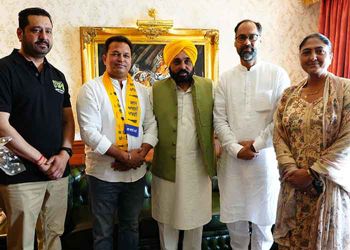Rahul Singh
The government has been tom-tomming to public as well as at international forums that India is the fastest-growing economy in the world. That may well be so, but where we have failed miserably – under both the Congress-led UPA and the BJP-led NDA – is in the social sector. Nowhere else in the world, except perhaps sub-Sahara Africa, do you find such glaring inequality, festering slums next to plush skyscrapers.
Here, I shall highlight only three areas: Primary education, primary health (which includes sanitation) and family planning. All three are closely linked. Without good healthcare and a high level of literacy, you cannot have a successful family planning programme. The much-touted “demographic dividend” will easily turn into a demographic disaster if the extra number of people in a rapidly growing population is either illiterate or so poorly educated that they cannot get suitable jobs.
The “demographic dividend” worked in some countries such as Thailand and Taiwan, even Indonesia, simply because their governments first laid the foundations by providing good primary education and healthcare. As a result, they had an educated workforce that could be gainfully employed in the manufacturing and service sectors, which are the main engines of growth in a modern economy.
Good healthcare also meant the survival of children and longer life spans. When couples comprehend that the children they bear are very likely to survive to a ripe old age, they have fewer children, perhaps two or three at most (this is known as the fertility rate). But they need to be sufficiently educated to understand that. And needless to say, to also have easy and affordable access to a variety of contraceptives. India has failed in all these social parameters. Ever since Sanjay Gandhi’s disastrous mass sterilisation programme during his mother’s notorious Emergency rule, a programme that was partly responsible for the Congress’s ensuing electoral rout in 1977, family planning has been a dirty word. Both the Congress and the BJP have steered clear of it and the only major contraceptive method used remains the same – female sterilisation. Whatever reduction there has been in the fertility rate of Indian women has been due to the forces of modernisation and urbanisation.
Nevertheless, India’s population growth rate, especially in certain states such as UP and Bihar, is much too high. An unsustainable 20 million people – an Australia — are added to the Indian population every year. Twenty million who have to be fed, housed, educated and employed. India has not been up to the task. Even a largely Muslim country like Indonesia has made greater strides in family planning, along with better healthcare and a higher literacy rate. When both India and Indonesia got their independence, roughly at the same time, India’s social parameters, in terms of literacy and health, were much better than Indonesia’s. Today, it is the other way around.
But perhaps our greatest failure has been in primary education. Surveys show that the learning outcomes of young Indian children are abysmal, especially of those enrolled in government-run schools. Even relatively poor families prefer to send their children to private fee-paying schools, rather than free government ones, essentially because the former provide better education. Fortunately, in recent years, far-sighted entrepreneurs like Wipro’s Azim Premji have spent several billion rupees of their wealth to promote foundations whose main objective is to fill the vacuum created by the government in providing poor children good education and healthcare. The result is that some 50 per cent of Indian children are now in private schools. This should have been the government’s responsibility, for which it has lamentably failed.
Our neighbour, Bangladesh, is a shining example of remarkable social progress. Written off as a “basket case” when it got its independence in 1971, it was far behind India and Pakistan. Today, it is ranked 91 among the world’s healthiest countries. Not very high, you would think. But where are India and Pakistan in the rankings? 120 and 124, respectively! An average Pakistani’s life expectancy at birth is 66 years, while that of a Bangladeshi is 72 years, six years more. While Pakistani has spent its resources on the military, nuclear weapons and breeding terrorists, Bangladesh has spent it on giving a better, happier life to its people. Take a bow, Dhaka.
— The writer is a veteran journalist



























